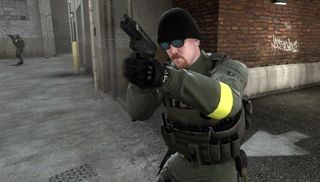How to win eco rounds in CS:GO

Every Monday in Shooterology , Evan writes about FPSes.
You're dead, and you're broke. How are you going to win the next round when the enemy team has body armor and rifles and you don't?
This is the daunting proposition of an eco round in CS:GO, when your team collectively decides to fight on a budget so it can afford a full complement of gear in the next round. As one of the regular hurdles of competitive play, mastering the eco round is an important part of winning. Here's how I try to make the best of an economic disadvantage.
Decide to win
I've solo-queued with so many people who see eco rounds are an invitation to play lackadaisically. You've got pistols, they've got rifles—let's just get this over with, right? In high-level competitive play, though, eco rounds regularly go the way of the underdog. Part of that is because pro players are so comfortable with pistols, but the other half of that is their mindset: they see eco rounds as an opportunity to gut their opponent's economy rather than a round that they're pre-destined to lose.
If you've already made your mind up that you're going to lose, congrats! You probably will.
Buy the pistol (or shotgun) you're most comfortable with
If pistols had a popularity contest, the P250 would win. It's beloved for a reason: it's a $300 weapon that can kill with a single headshot at close range. It's more versatile and more accurate than the Deagle in most situations. But if the Deagle or Five-Seven somehow speak to how you play Counter-Strike (and you don't mind buying one fewer grenade next round to offset the cost), go for it. There's plenty of math you can hold up as evidence, but I'm a big believer in the idea that you're going to perform best with the weapon you feel the most confident with.
Don't rule out shotguns completely, either: mid- and late-game eco rounds are one of the situations where shotguns have a lot of utility. A Nova at $1200 or a MAG-7 at $1800 are several times the cost of a pistol, and tend to favor defensive use, where you can dictate the range that you encounter enemies and pick spots that force enemies to look two ways as they cross a narrow area (like the ramp on Nuke, or banana on Inferno). Holding a weapon that deals a lot of damage all at once is a way of compensating for your fragility and the accuracy-destroying power of aimpunch .
PC Gamer Newsletter
Sign up to get the best content of the week, and great gaming deals, as picked by the editors.
Make the enemy encounter multiple pistols at once
Unless you brain an enemy, you're going to have to shoot them more than they shoot you. Offset that disadvantage by positioning yourself with a teammate to see and shoot an enemy at exactly the same time. If you're covering an entry door, your teammate shouldn't be able to see an enemy before you do, and vice versa. Because there's less room for error, your timing and angles count a lot on an eco.
Do something ridiculous
On the surface this seems like it runs contrary to “Decide to win,” but think about it this way: one of your biggest advantages on an eco round is that you've got less to lose. Try a strategy that your opponent would never expect, like rushing everyone through palace on Mirage, or making a hard balcony push on the T side of Inferno. On defense, consider stacking a single bombsite with your whole team in the hopes that the Terrorists will split their attack.
If you can't beat 'em, rob 'em
CS:GO is a pay-to-win game: buying power equals firepower. When you steal a weapon from a dead enemy, you're fighting on their tab. Given the choice between fighting on the wrong side of a three-on-one with no armor and cowering in a corner with a nicked AWP, save the AWP . You're probably going to lose more eco rounds than you win, so be willing to take a small gain out of a bad situation.
If the enemy knows you've taken an AWP or another valuable weapon, it may even go out of its way to hunt you down in the final moments of the round. In this situation, a secondary, riskier way to do economic damage to an opponent on an eco is to go for “exit kills,” or positioning yourself to lose the round, but kill one or two players as they're exiting a known position (usually one at a time, to look for you in the waning seconds of the round).

Evan's a hardcore FPS enthusiast who joined PC Gamer in 2008. After an era spent publishing reviews, news, and cover features, he now oversees editorial operations for PC Gamer worldwide, including setting policy, training, and editing stories written by the wider team. His most-played FPSes are CS:GO, Team Fortress 2, Team Fortress Classic, Rainbow Six Siege, and Arma 2. His first multiplayer FPS was Quake 2, played on serial LAN in his uncle's basement, the ideal conditions for instilling a lifelong fondness for fragging. Evan also leads production of the PC Gaming Show, the annual E3 showcase event dedicated to PC gaming.
Most Popular

